The morning after: a bit of downtown and the airport
The morning after: a bit of downtown and the airport

It’s the morning after the Games, and all the people have disappeared!
I took a quick look at Waterfront this morning, after heading to YVR to see the crowds (more on that later in this post.)
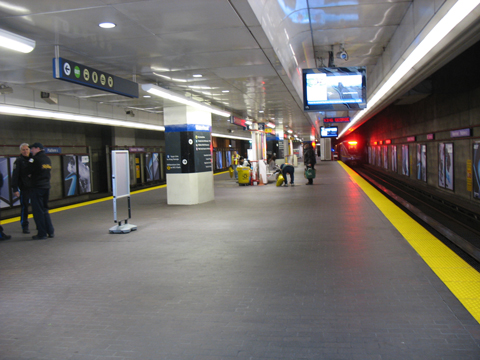
The platform for Expo/Millennium Line was not busy.
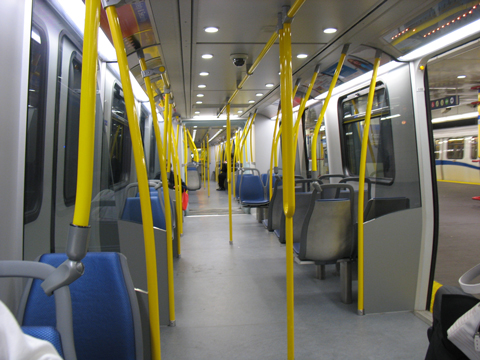
It was quiet on the train as well.
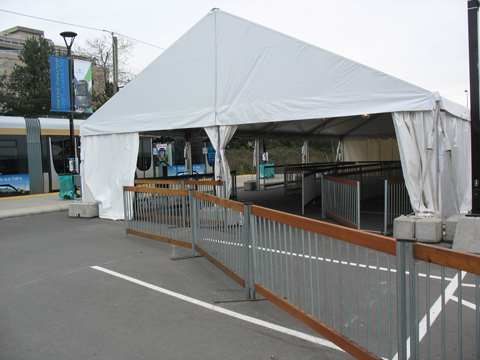
Even the lineups at the Olympic Line streetcar have dwindled. The line operates until March 21, so hop on while you still can!
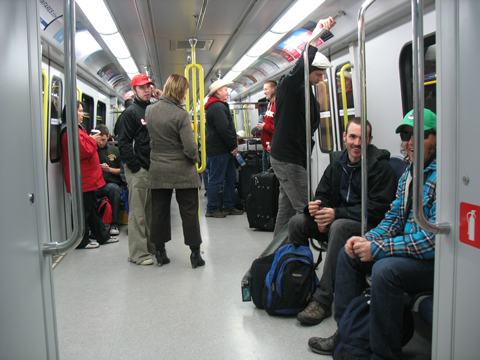
On the way to YVR, however, a steady stream of passengers were heading to the airport. It wasn’t super full, but it wasn’t empty, either.
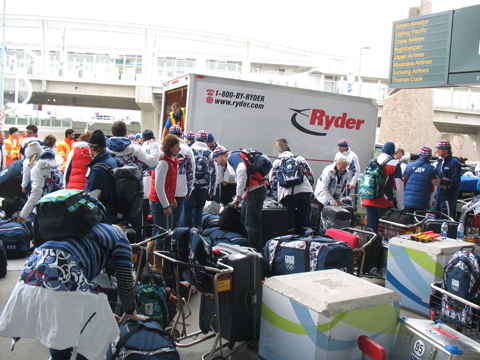
And when I got to the airport, I arrived just in time to see the Czech team unloading all its stuff! There was an entire Ryder cube van filled with just luggage and sporting equipment.
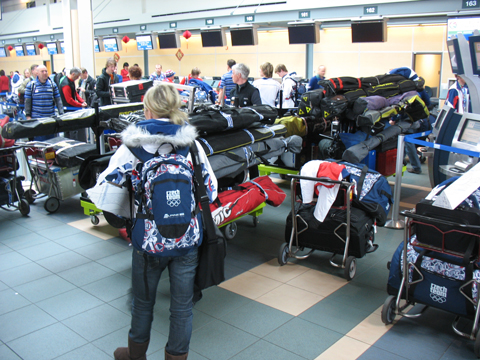
Have you ever seen so many skis packed up for a plane? I wonder how the baggage allowance works for Olympic athletes!

The airport seemed to have it all under control though, despite the terminal being undeniably busy. Mascots like BeeBop here were walking around and entertaining people. Check out the post at YVR’s blog which shows BeeBop playing hacky sack with the Czech athletes!
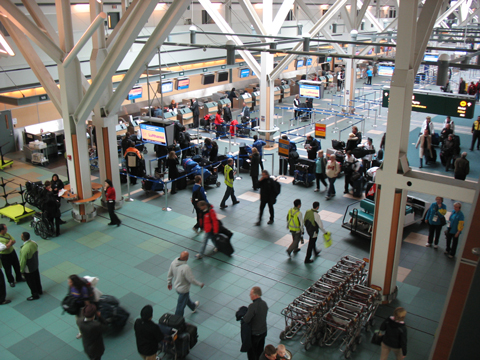
See, here’s the international departures area — it was flowing well and not too tied up with people. Well done, YVR!






Is the Canada Line operation back to normal now? :)
Love your blog!
Yes, it’s back to normal now!
It’s so nice and quiet .. Missed it!
The city and the transit system is like a ghost town now, pretty creepy.
You should see the roads. It looks everyone decided to drive back to work today. I carpool halfway and traffic was heavier than during the Games. Then I catch the B-Line for my last leg and it was pretty busy in the morning.
Maybe it’s just the Canada Line that has quieted down?
I was so lonely on my SkyTrain home this eve! :(
They say people have hopped back in cars because transit service has been cut back to pre Olympic levels. They mention three specific items:
1. 150 less buses
2. one less SeaBus (two ratehr than three)
3. they said ‘less trains on the Canada line’…they must mean ‘reduced hours’ rather than a lesser number of trains .. right?
You know, I’m sure it costs money to have those things… but in the broad scheme .. it doesnt seem like much. Consider: Translink has what? 1200? 1500 buses? To add another 150 is like 10 percent.
And increasing hours on an automated driver-less Canada line? I mean, the tracks are built, the trains are bought .. just to extend operations by a few hours each nite would just mena a few more hours of pay for some staff… and maybe some xtra electricity/power consumption?
I donno,,, it almost seems .. do-able.
@rob,
While I agree with you that people definitely do not embrace transit because of the reduction to pre-olympic service levels I do not think the model that Translink was using to support ridership during the games was sustainable for (A) their budget and (B) the equipment. I am sure that Translink was able to support extra buses, seabuses and trains due to the fact that many of the main lines would be packed to the brim for most of the days bringing in extra fare revenue. However to run all the extra equipment full time would come at a cost. Currently the breaks/reduction in operating hours in the rail cars not only removes trains from operation when collected fares would not offset the cost of operation in any logical way but also provides adequate time for preventative maintenance both on the train cars and the rail lines. The same applies to the seabuses, in fact the new seabus, I believe, was purchased with the intent to allow one of the other two older seabuses to be removed from operation for extensive overhaul or even replacement (I’m not sure). There is concerns over the aluminum hull of the older vessels (cracking). As for buses, I think this one may be more doable, especially if what you are saying is correct about the total fleet size, but still will the collected fares offset the extra cost of operation? Probably not. If you are running your entire fleet already at say an average of 50% capacity or less (consider non-peak hours) then adding 10% more buses would drive this average capacity level down even more and hit your bottom line even harder. Translink is in it for the money in the end, as harsh as that sounds, but like any company they need to turn a profit if at all possible, and gas taxes, property taxes etc can only go so high (at least I hope!). As for me I totally see your point, there is no way I could feasibly justify taking transit on a daily basis. I feel the downtown core has excellent transit options and I much prefer taking transit downtown, however the rest of the lower mainland is greatly lacking. So I take my car, even though I am paying for transit every time I fill it up. This is all just information I gathered from previous Buzzer blogs, I am not a Translink rep so don’t take my word without a grain of salt. Hope this helps though!
Hi Jhenifer, I asked you some questions in part 1 and part 6 of fleet overhaul on February 28th 2010. Can you answer them for me please
Hey Jhen,
Can you get us some images of the Seabus hull cracks?
Ric: Yes, I will get you those answers.
Caleb:
I’d say you’ve pretty much nailed it!
Ric: here’s the answers you asked for.
By “operating garages” are you referring to transit centers? Also are the electrical repairs like to ones I referred to done on a regular basis?
Yes, operating garages mean the transit depots. Each depot has garages that do limited repairs — Fleet Overhaul does the huge jobs that those garages can’t do. Those electrical repairs are done on a regular basis.
;-)
Sorry, we don’t have any to share!
Hi Jhenifer, Oops I forgot to ask you this. If there are no community shuttles in the Richmond and Burnaby transit center, where do the Richmond and Burnaby community shuttle routes operate out off? Also for the electrical repairs that I mentioned I asked whether they are done on a regular basis. I meant to ask how often they are performed. Are they done: Once a week? Once a month? Once a Year? Once a day?
@Ric
while I don’t know the exact preventative maintenance schedule for the buses. I can say that 3 months is the standard interval for most commercial type vehicles. At that time they would do an oil change. Check the steering and brakes. Also checking all the lights and making sure everything is working as it should. Example windows open, doors open.
Also they probably do a quick check of the lights, brakes , and possibly steering every day. Fixing what they can right away or if not pulling it out of service until the repairs or done if they are serious enough. In fact it is required by law that every commercial vehicle have its lights and brakes checked before going on the road by doing a pretrip.
Also every 6 months to a year, not sure which, there would be a CVI (commercial vehicle inspection) done by a licensed mechanic.
Also during the day they would never have every single bus in service. There is always a small percentage that are either being repaired or parked ready to replace a bus that needs to be repaired.
Ric:
To add to Paul’s answer, here is what I’m told.
Jhen, one more thing. Why don’t community shuttles need to go into fleet overhaul? Is it because they are small enough that the garage at the transit centers can do all the necessary repairs?
Yes. Also, the hoists and other maintenance equipment at Fleet Overhaul are customized for the conventional and articulated fleet — the smaller garages have the specialized equipment for the shuttles.
Jhen, Your answer from my previous question sent to question to my mind. Where are repairs such as oil changes for the conventional and articulated buses done? Also where are repairs for the highway coaches done?
Ric: All minor repairs are done at each respective transit centre, which includes oil changes and such. Highway coaches aren’t separate from conventional buses — minor repairs would be done at the transit centres, and the major repairs at Fleet Overhaul.
Thx Caleb, makes sense. What u are saying is that ‘build it and they will come’ .. is not the way it is. In other words, just increasing the service will not expand ridership to the extent that it will cover the increased costs.
The greater ridership was due to the Games.. not just due to higher transit capacity.